- ~ Home
- ~ Camino Portugués (The Portuguese Way)
- Day Nineteen, Central Route, Rubiaes to Tui
Jump to Camino Portugués Stages
Day Nineteen on the Central Route of the Camino Portugués ~ Rubiães to Tui, 19 Km (11.8 Miles)
Disclosure: the PilgrimageTraveler.com is an associate of Booking.com, Roamless, and Amazon. As associates of these merchants, we earn from qualifying purchases from our links.
Day nineteen on the central route of the Camino Portugués was another fabulous walk through the Portuguese countryside, then a tour through the medieval city of Valença with its amazingly preserved fortress walls, an international crossing on the Minho River to Spain and the grand finale in the medieval Spanish city of Tui. For what more could a pilgrim ask?
"Believe in Love's infinite journey, for it is your own! For you are Love, Love is Life." ~ Rumi
Team Magdalena was in full force today, lifting everyone's spirits as we moved together through day nineteen on the Portuguese Way, along the central route. It was a day of Love, Fun and Laughter!
🙋♀️ Why Trust Us at the Pilgrimage Traveler?

We’re not a travel agency ~ we’re fellow pilgrims! (See About Us)
We've trekked Pilgrimage Routes Across Europe since 2014!
💬 We’ve:
- Gotten lost so you don’t have to. 😉
- Followed waymarks in the glowing sunlight, the pouring rain and by moonlight. ☀️🌧️🌙
- Slept in albergues, hostels & casa rurals. Ate and drank in cafés along the way. 🛌 😴
- Created comprehensive and downloadable GPS maps and eBook Guides, full of must-have information based on real pilgrimage travels. 🧭 🗺️
- Shared our complete journeys, step by step to help YOU plan your ultimate pilgrimage and walk with your own Heart and Soul. 💙✨
Every detail is from our own experiences. Just fellow pilgrims sharing the Way. We have added a touch of spirituality, heartfelt insights and practical guidance from the road ~ offering a genuine connection to the spirit of pilgrimage. Tap into the wisdom of seasoned pilgrims!
Ultreia and Safe Pilgrimage Travels, Caminante! 💫 💚 🤍
Map and Stats of Day Nineteen on the Central Route of the Camino Portugués
Here is our google map, created from our GPS tracks, with accommodation, cafés, grocery stores and other useful landmarks, to aid you in your planning for the day.
The mileage is from our Albergue Ninho, only 1/4 mile down the road from the municipal albergue to the cathedral in Tui, so you will need to add this amount to your total if you are starting at the municipal albergue. You will also need to add an additional meters if going onward to other accommodation to the north in Tui. Of course, if you are landing at an accommodation in Valença, it will be less.
The elevation profile is very doable, with lovely uphill sections initially, on cobblestone, followed by a downhill cruise on old Roman roads and villages through the countryside toward the River Minho.
👣 Camino Portugués eBook Guides
Enjoy all the valuable info from our web pages ~ offline, ad-free, and beautifully formatted, including our photos. Why carry a heavy guidebook when you can use a nimble digital version on your device?
Our guides are frequently updated and uniquely entertaining, as we share our own Camino story along the way.
📲 Instant download. 💸 Money-back guarantee. 🔄 Free updates for 1 year.
Buy only what you need ~ or grab all four for the price of three (25% savings). Click here for more information or BUY NOW at only 17.85!
Jump to Camino Portugués Stages
Photo-Rich Travelogue of Day Nineteen, Central Route of the Camino Portugués
All of our Camino group decided to meet in front of the Albergue Ninho to walk together. We decided the night before that Magdalena, our wheelchair-bound friend, would join us, despite long sections off-pavement. All of the strong and able-bodied men agreed they would join in, taking turns during the rougher sections. We set off, down the EN201 in the early morning light.
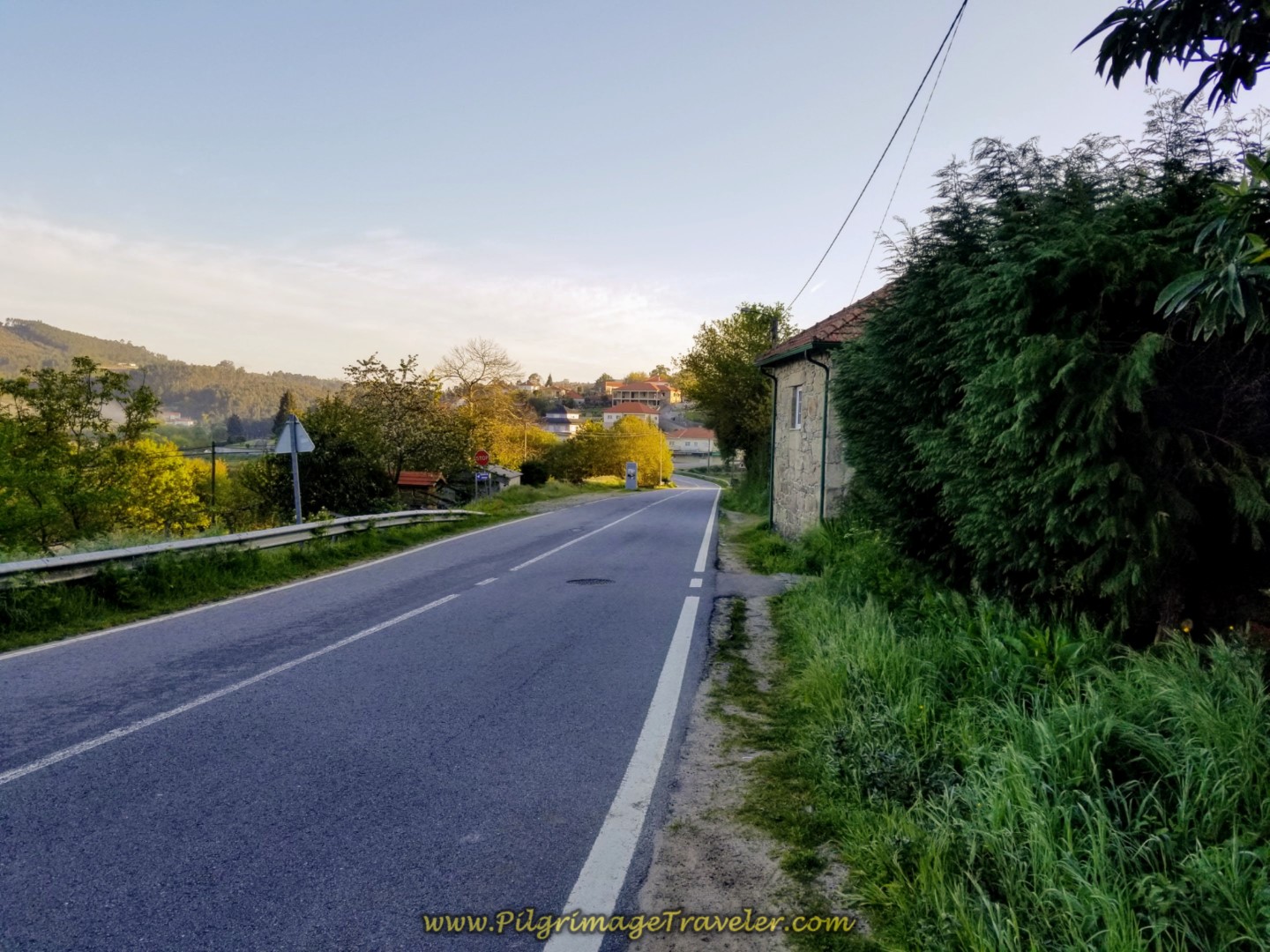 Leaving on the EN201 from the Albergue Ninho
Leaving on the EN201 from the Albergue NinhoAfter only a few meters, the Camino turns sharply left onto a narrow cobblestone lane, shown below.
 Michal and Magdalena Navigate on the Cobblestone Lane
Michal and Magdalena Navigate on the Cobblestone LaneWe all had our breakfast in our albergues, but the map shows you several cafés at the start of the day, if you need them.
Within just about 650 meters, we came to this charming old Roman bridge, crossing the Rio Coura.
A few meters after the bridge, the Camino turns right onto another cobblestone lane and in about 200 meters more the lane meets the EN201 and crosses it here at this signpost, directing the pilgrimage traveler toward the next town of Cossourado.
 The Waymark to Cossourado
The Waymark to CossouradoThere is a café right by the sign above, to the right of it, on the EN201, if you need it. There is another café about another 150 meters to the left of the sign, also on the EN201, if the first is closed.
Follow this lovely narrow cobblestone lane and within only 150 meters or so, this waterfall on the Rio Coura is reached. One-by-one we stopped here to take it in. It is a serene and lovely place, perfect for a photo opportunity.
Pictured below, is the attractive Via Romana waymarks that you encounter along the way, letting you know that this indeed is the way that the Roman roads once took. It is fabulous to be reminded of this historical fact.
As the way steepened, Magdalena needed more assistance to keep up with us. The guys were up to the task and quickly figured out how to tag-team it.
 Matt, Borut and Rich on Push-Pull Shared Duty
Matt, Borut and Rich on Push-Pull Shared DutyWe followed this rugged cobblestone lane for a total of 1/2 kilometer.
For the first half of day nineteen on the Camino Portugués via the central route, the Way essentially traces the path of EN201, weaving around it to the east or west. Shortly after the above cobblestone section, the Camino joins the EN201 for about 1/4 kilometer, then turns off to the right, on a paved side road. Then several hundred meters later, turns left and joins the dirt road, shown below.
 Camino Team Walking on Rural Lane
Camino Team Walking on Rural LaneThis country lane goes on for over one kilometer, and just before it ends at a T-intersection, below, the team celebrates their arrival together, thus far.

At the T-intersection we took a right turn onto a narrow paved road and we walked toward the next town of Pecene. Within 300 meters or so, the small chapel below, caught my eye. This chapel is attached to the Casa da Capela, a rural hotel right along the Camino.
 Chapel and Casa da Capela, Pecene
Chapel and Casa da Capela, PeceneContinuing on the paved road, in another 1/2 kilometer, we entered the next town of São Bento da Porta Aberta. At the first intersection in town is the Café Castro, at the high point of the day, where we had our first break after only about 4.0 kilometers into our day nineteen on the central route of the Camino Portugues.
Here we are, milling around outside as we drank café con leite with lots of sugar!
The town church is just opposite the café, where we joined the EN201 once again and walked north, turned off it to the left almost immediately and just after the church which dominates the center of town.
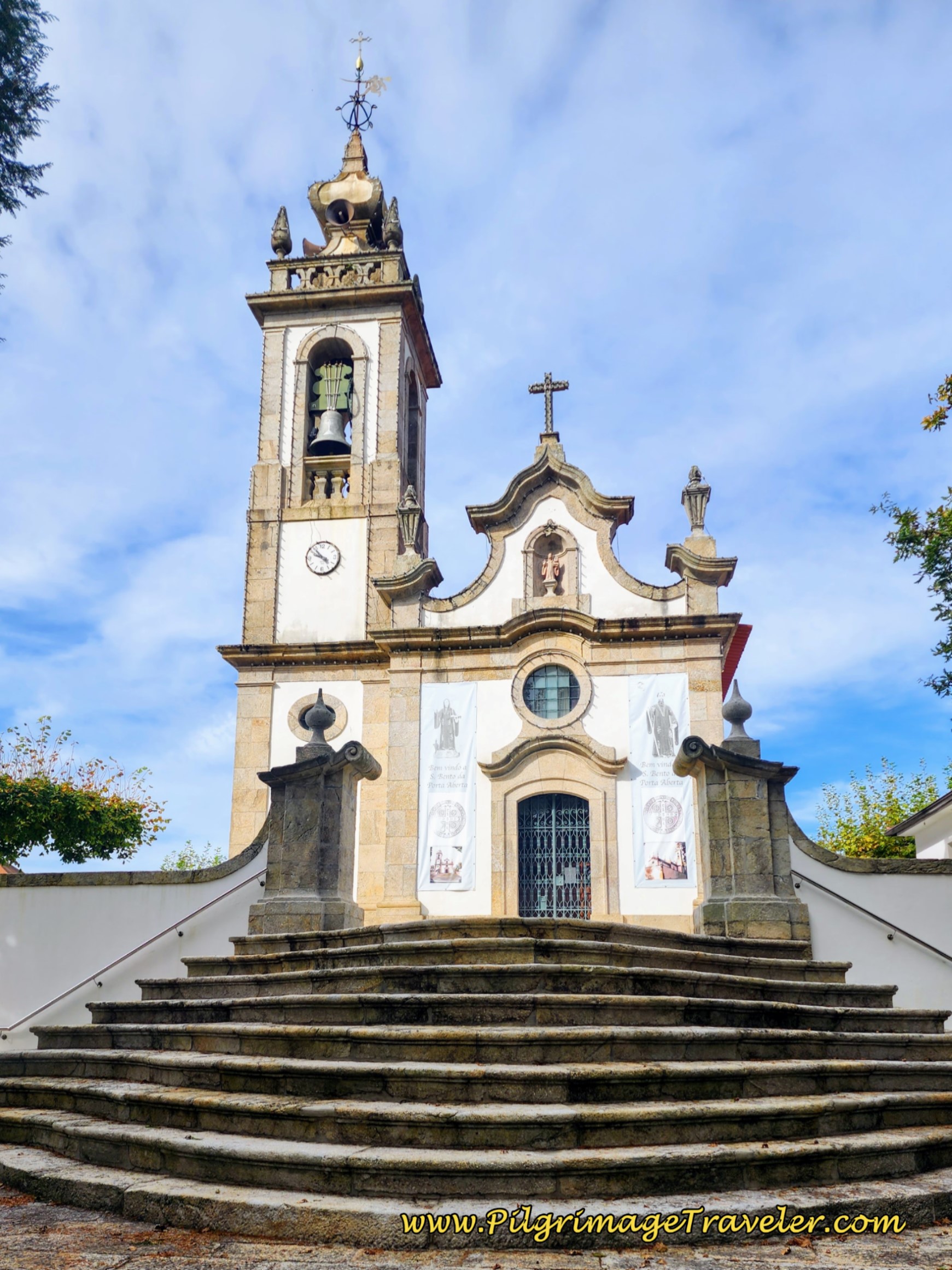 Igreja de São Bento da Porta Aberta
Igreja de São Bento da Porta AbertaJump to Camino Portugués Stages
After the left turn, the road is made of cobblestone initially and then quickly turns into this ancient Roman road, shortly after town.
The gentlemen hovered over Magdalena, during this section, assisting her as needed, as you can see in the next photos. It was so sweet to see! At least it was downhill!
 The Guys Checking Out the Wheelchair
The Guys Checking Out the Wheelchair Rich and Borut Guide Magdalena Through the Ruts
Rich and Borut Guide Magdalena Through the RutsAfter about 1.15 kilometers, we emerged from the forest and were back on the "easy" cobblestone on the way to Gontomil.
In about 100 meters we joined the EM1063 on nice downhill pavement.
 Magdalena Smiles as She Cruises on the Paved Road
Magdalena Smiles as She Cruises on the Paved RoadThe easy breezy pavement was short lived, and after only a few hundred meters, the Camino turns right onto the Rua dos Limas. Here Magdalena is working her way up the hill on the narrow cobblestone road. She was doing amazingly well on day nineteen of the Portuguese Camino on the central route.
 Right Turn Onto the Rua dos Limas
Right Turn Onto the Rua dos LimasFarther up the hill it just got too steep for her to make much progress, so Rich and Magnus assisted her in her efforts. Fortunately, this section was only a brief 150 meters or so.
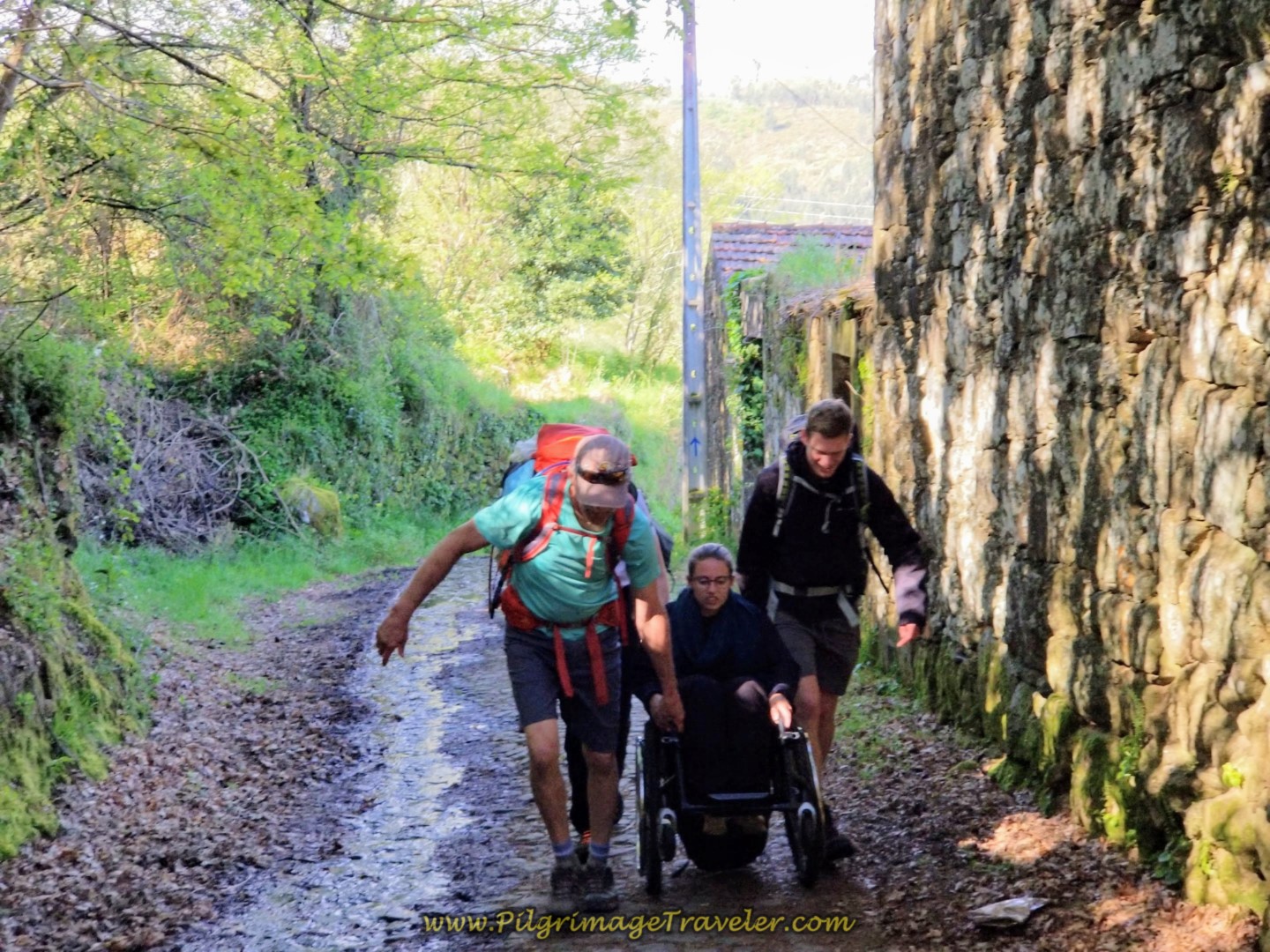 Steep Cobblestone on the Rua dos Limas
Steep Cobblestone on the Rua dos LimasThen it was a left turn onto another steep and downhill dirt lane (not pictured) for about 1/3 kilometer, before we joined the Rua da Pereira, shown below, for a long, paved downhill run toward Fontoura.
 Long, Paved Downhill on the Rua da Pereira
Long, Paved Downhill on the Rua da PereiraIt was about here that I decided to walk ahead of the Camino group with Miriam agreeing to join me. Many weeks prior, Rich and I had agreed to meet our Camino friend Glyvia, in Valença at 2:00 in the afternoon on day nineteen of the central route on the Portuguese Way.
I realized that all this difficult terrain was slower going than I had expected. If I were to meet our friend, I needed to get going! We had less than three hours left to make the remaining 9.0 kilometers to Tui. Sounds quite easy, but I wanted to be sure.
Miriam and I left the group to walk faster. The Rua da Pereira was easy to negotiate on long downhill pavement. Look for the turn off to the Quinta de Real along this section and a few steps off-Camino. About 2/3 of a kilometer later, we were directed to the right, onto this narrow path along a canal lined with a grape arbor.
The lovely 200 meter shortcut along the canal dropped us out onto the EM512, shown below, where the Camino turns to the right to walk into Fontoura.
 Walking Into Fontoura on the EM512
Walking Into Fontoura on the EM512Pass by the Casa da Quinta do Cruzeiro after entering town. Look for the turn off, just before the town chapel. Next, pass the town chapel, shown below, which is the landmark for the recommended, private albergue called the PilgerPause, just across the street.
There is also a cafe across the street from the church, the Taberna da Igreja, if you need it! The church and albergue are at about 7.2 kilometers total for the day.
 Taberna da Igreja
Taberna da IgrejaAfter about 3/4 kilometer more, we left the EM512, turning to the left, for this cobblestone road.
 Northward from Fontoura on Cobblestone Road
Northward from Fontoura on Cobblestone RoadWe followed the road as it turned into a dirt lane en-route to the next town of Paços, below, on day nineteen on the central route of the Portuguese Camino.
After walking another 3/4 kilometer, we crossed the EN201 for the final time, staying straight on. If you were to follow the EN201 to the left and west, you would encounter a café and a grocery store if needed.
In less than another one-half kilometer, you encounter this intersection, below, in the town proper of Paços.
 Entering the Town of Paços
Entering the Town of PaçosThe Camino crosses over the pavement, shown above and picks up a narrow cobblestone lane to the left.
We stayed on the cobblestone lane for about 1/4 kilometer, turning right onto a paved road at the next intersection, and then an immediate left onto this lovely arbor-lined road, shown below.
After only another 100 meters, we arrived at the next landmark, the Café and Albergue Quinta Estrada Romana, shown below. This place looked very inviting and if not for my time constraints I would have stopped for coffee and a treat! We were at 9.75 kilometers total for the day.
 Onward on Tree-Lined Cobblestone Road to Pedreira
Onward on Tree-Lined Cobblestone Road to PedreiraThe Camino continues on the cobblestone lane, staying on it all the way to the Ponte Romana da Pedreira, shown below, 600 meters or so from the Albergue Estrada Romana. The bridge is at about the halfway point for the day, and old town Valença is only a bit more than six kilometers away.
 Miriam and the Ponte Romana da Pedreira
Miriam and the Ponte Romana da PedreiraJust after the Roman bridge, on the right is the Quinta do Caminho, yet another country estate where you can spend the night.
After the Quinta, the Camino crosses over the paved M1057, and continues directly northward, through the countryside on dirt and cobblestone lanes, staying straight on at every intersection for the next two kilometers.
 Country Roads to Valença
Country Roads to ValençaJust before the industrial buildings appear on the outskirts of Valença, you will see this "Welcome to Valença" sign, shown below! You are at about 12.2 kilometers total at this sign.
 Welcome to Valença Sign
Welcome to Valença SignShortly after the Welcome to Valença sign, the route becomes quite a bit more industrial-looking, turns right and joins the N13.
After a few meters at the first large roundabout, below, find the nice side road to the left, the Rua da Veiga, 2nd photo below.
 Left at the Roundabout on the N13
Left at the Roundabout on the N13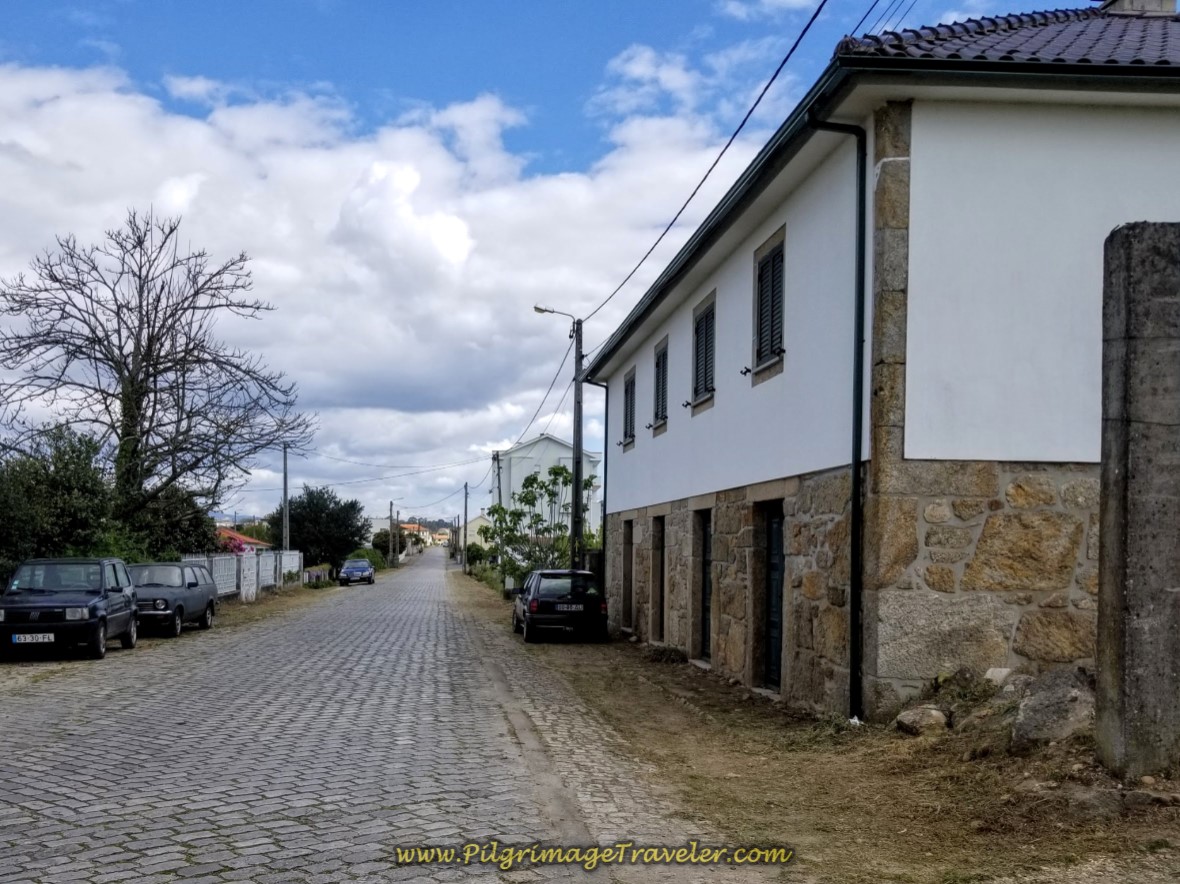 Rua da Veiga towards Valença
Rua da Veiga towards ValençaThe Rua da Veiga parallels the busy N13 to the west to walk into Valença proper. After a bit more than 1/2 kilometer, turn left at this chapel, the Capela do Sr. do Bomfim.
 Turn Left at the Capela do Sr. do Bomfim
Turn Left at the Capela do Sr. do BomfimAfter making the turn, you encounter the Arão sign on day nineteen on the central route of the Portuguese Camino, pictured below.
 Welcome to Arão Sign
Welcome to Arão SignWe walked westward on the Rua do Eido de Cima, another 400 meters or so, to the next chapel, shown below, where the Camino turns right onto the Rua do Regueiro, back to the northerly direction.
 Right Turn at Capela onto the Rua do Regueiro
Right Turn at Capela onto the Rua do RegueiroWalk about another 300 meters, and turn right at this cruzeiro, below, on day nineteen on the central route of the Portuguese Camino. The total kilometers at this cross, thus far is fourteen.
 Turn Right at Cruzeiro
Turn Right at CruzeiroJump to Camino Portugués Stages
A one kilometer long stretch on paved road, shown below, eventually brings you to a T-intersection, where you turn right, walking for another 1/4 kilometer, then turning right onto the Av. Sá Carneiro at a large roundabout and finally turning left onto the northward-bound N13 again.
 Valença High Rises Ahead
Valença High Rises AheadIf you were to turn right on the N13, an economical hotel, the Hotel Valença do Minho, (+351 251 824 392), is about 250 meters to the south. To the east of the hotel is the brand-new Valença Guesthouse, which gets good reviews from fellow pilgrims.
Going northward instead, on the the Camino, about another 1/2 kilometer on the N13 brings you to a roundabout in the heart of Valença on day nineteen on the central route of the Portuguese Camino.
The Camino goes straight on through the roundabout, and you will see a Camino waymark, along its left flank, with a 117-kilometer reading to Santiago on it, see below. However, if you were to turn left here, onto the N101, you will come to the municipal Albergue São Teotónio. The albergue is about 300 meters westward just a few steps to the south of the N101 at the next large roundabout. Consult our map above for its precise location.
On the way to the albergue you would pass by three more accommodations, all economical, outside the old fortress walls; the Residencial S.Gião, the Hotel Val Flores and the Hotel Lara.
But Miriam and I continued on the Camino, walking north on the Avenida dos Combatentes da Grande Guerra toward the fortifications.
 Toward the Fortifications of Valença
Toward the Fortifications of ValençaThe fortress walls of Valença rise in front of you as you walk down the Avenue. They are well-preserved pieces of Gothic and Baroque military architecture.
According to Wikipedia, "The first walls were built in the 13th century. It was upgraded during the 17th and 18th centuries forming the present bulwarked system. It is placed on top of two small hills and it is formed by two polygons (the Recinto Magistral and the Coroada) separated by a ditch and with four doors (Coroada, Gaviarra, Fonte da Vila and Sol). The main entrance is the Porta do Sol (Sun's door). This door was damaged during the Napoleonic invasions."
While Miriam and I were admiring the fortress walls, and I was texting my friend, I received a text from Rich, stating that they were also already in Valença. He and the others were having a beverage at the Café Mané, where we had passed by minutes ago! We re-traced our steps to join them. As it turned out we made no better time than they did!
After a break at the café, nearing 2:00 o'clock, Rich and I set out to find our friend, Glyvia. We walked back to the fortress, to go inside the walled city to meet our friend.
Here is the East door, the Porta do Sol, pictured below, where we entered the old city at approximately 16.3 kilometers for the day.
 Elle at the Porta do Sol
Elle at the Porta do SolWe followed the Camino through this door and walked up the street and right to the Praça da República, the main hub of the medieval city. Not having seen Glyvia, we stopped at the Café Cantinho, shown here, in the square, to have a sandwich. We knew she would eventually walk this way.
And sure enough, we saw her walking down the street within a few minutes. We waved her our way, and she joined us for a drink. It was a joyful reunion for us since we had not seen her since the prior year when we walked the Coastal Route right by her house. Here we are, posing, at the wall.
 Rich, Glyvia and Elle on Valença's Rampart Walls
Rich, Glyvia and Elle on Valença's Rampart WallsIf your day were to end here inside the fortress walls, to the south of the Republic Square is the economical Hostel Bulwark with dormitory beds, the Residencial Portas do Sol and the Alojamento da Vila, just steps away. To the north is the Pousada Valença and to the east is the Domus Avocat. It would have been lovely to spend more time here to explore this medieval city! (In fact, later, after our Camino, we returned to Valença as tourists and thoroughly enjoyed staying in the heart of the old city, at the wonderful and friendly Alojamento da Vila.)
Soon the rest of the group came through the square, and we all gathered together to explore the old city. Then we continued on together from the Republic Square, heading northward through the streets of Valença on the Rua de Mousinho de Albuquerque, past the shops and an old church on the Camino de Santiago, shown below.
 Past the Shops of Valença on the Camino thru the Medieval City
Past the Shops of Valença on the Camino thru the Medieval City Through the Streets of Valença on the Rua de Mousinho de Albuquerque
Through the Streets of Valença on the Rua de Mousinho de AlbuquerqueThe Camino takes a glorious path through the medieval city and through the rampart walls. I had Mira, from Korea, who had joined our group the previous day, stand by the northern door, the Porta da Gabiarra, as we exited Valença shown below.
Jump to Camino Portugués Stages
After leaving the walls on the hill, we did the final descent to the Avenida de Espanha on long steps, shown below, on day nineteen of the central route on the Portuguese Camino.
A left turn onto the street at the bottom of the steps, the Avenida de Espanha, led us to the Ponte Internacional, or the international bridge between Portugal and Spain. This bridge was built in 1879 when Portugal and Spain agreed to construct a bi-functional (road and train) bridge. The bridge is still in use although a new bridge was built southwest of the older one.
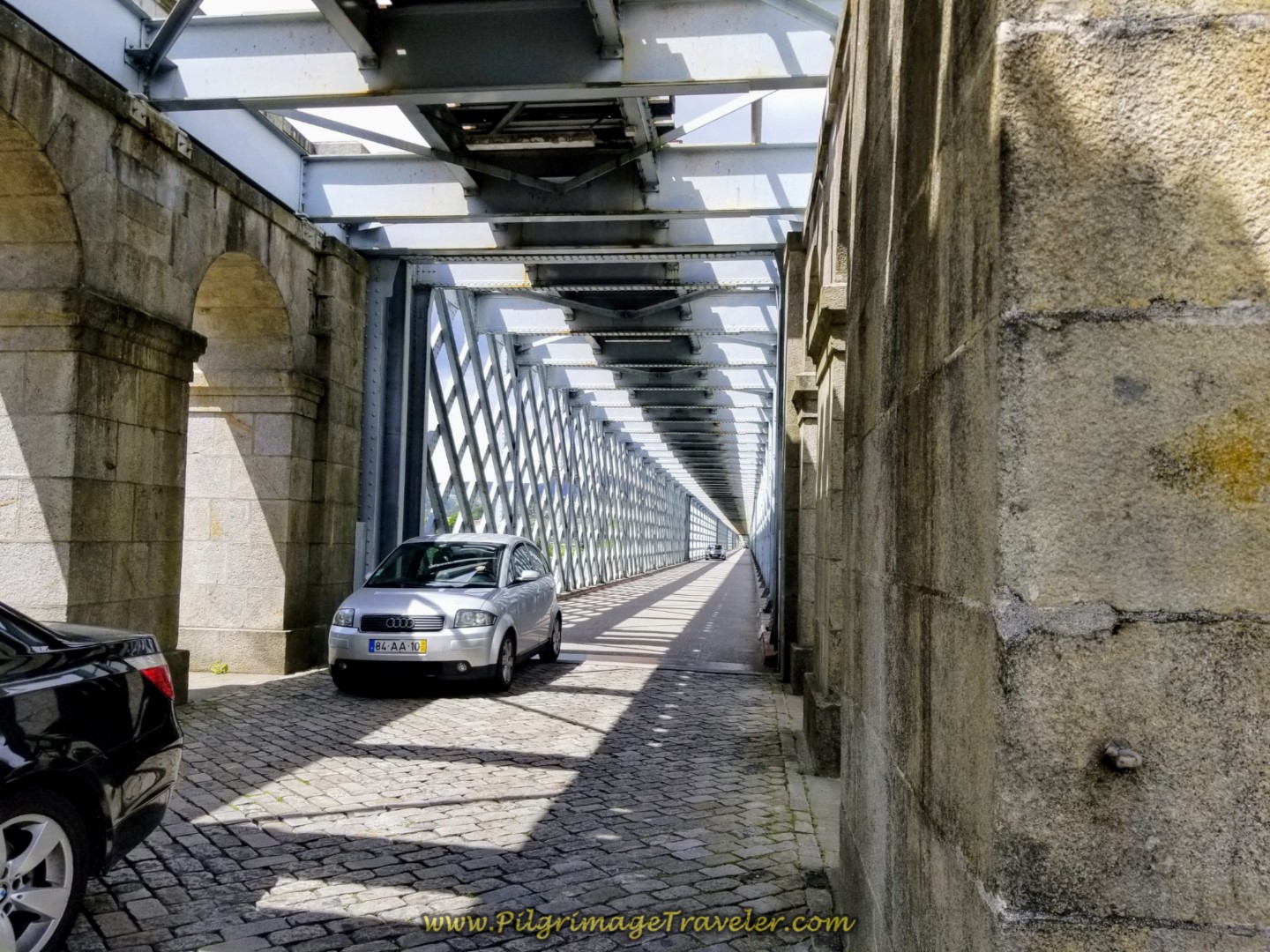 Ponte Internacional Tui-Valença - Lower Level for Cars
Ponte Internacional Tui-Valença - Lower Level for CarsBy the time you reach the international bridge after 17 kilometers into the day, you can see the prominent Cathedral of Tui on the hill ahead. It is only about 2.0 kilometers away.
The train tracks are on the upper level of the bridge, along with the pedestrian walkway.
There is a spot in the middle of the bridge where the country boundary is crossed. I decided to put one foot in Portugal and one in Spain, in the typical fashion. One-by-one everyone wanted a photograph of this. And before long, the clowns took over with their antics. Who could resist taking a silly picture??? (But alas, the border line is no longer evident, but I kept the goofy photo anyway!)
 Matt, Borut, Michal, Magnus and Rich with One Foot in Portugal, One Foot in Spain
Matt, Borut, Michal, Magnus and Rich with One Foot in Portugal, One Foot in SpainAfter walking over the bridge, the Camino turns right to follow the N-551, where a large España sign greets you. I was happy and sad at the same time. No more Nata - boo hoo! No more hobblestone - yeah!
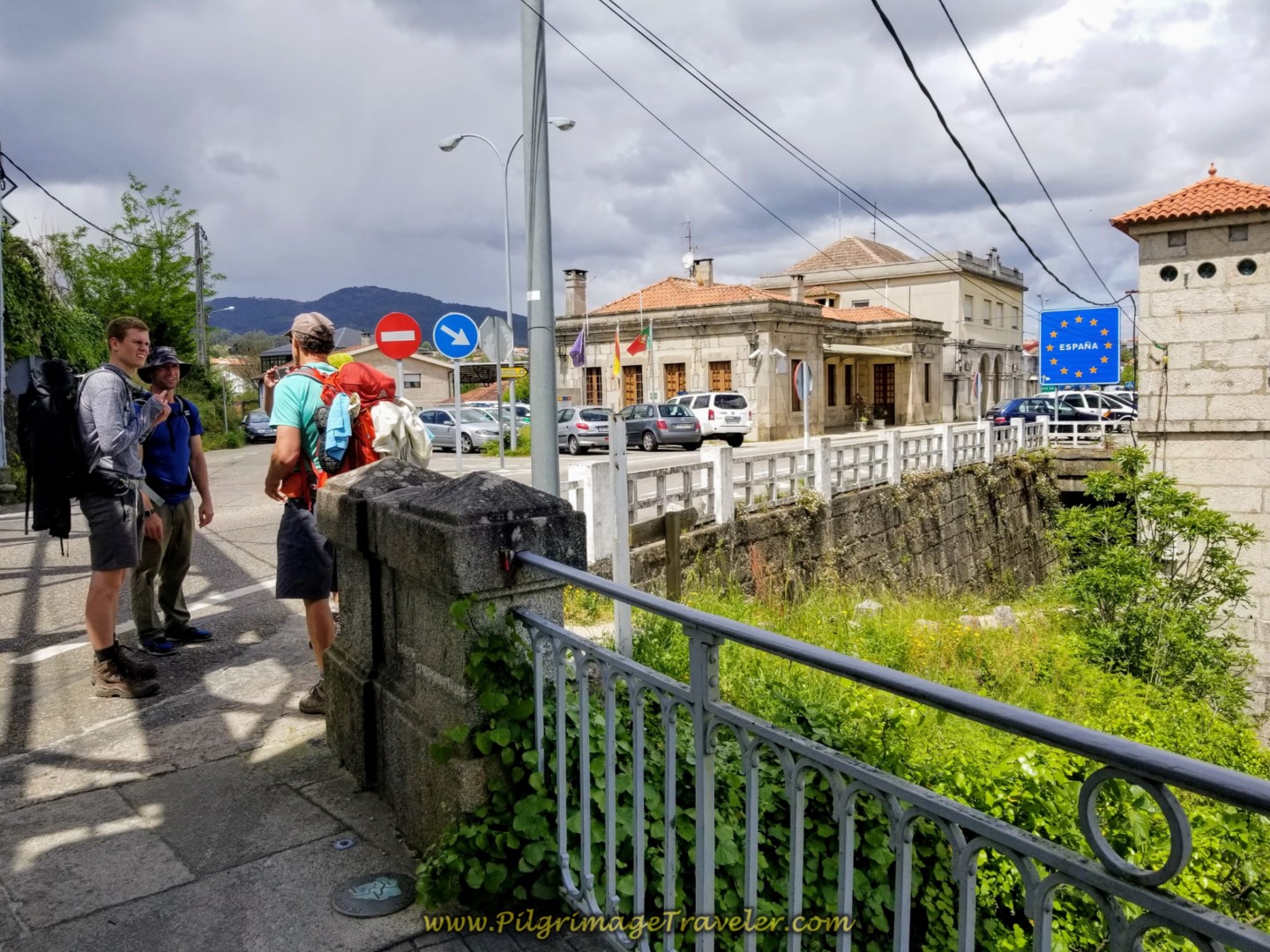 Turn Right onto the N-551 in España
Turn Right onto the N-551 in EspañaAfter about 400 meters on the N-551, you turn right onto the Camiño Tenencia. Here is a photo of the street, as Borut and Magdalena walked by the entrance to the Parador de Tui, shown on the left, below. Hmmm, if only!
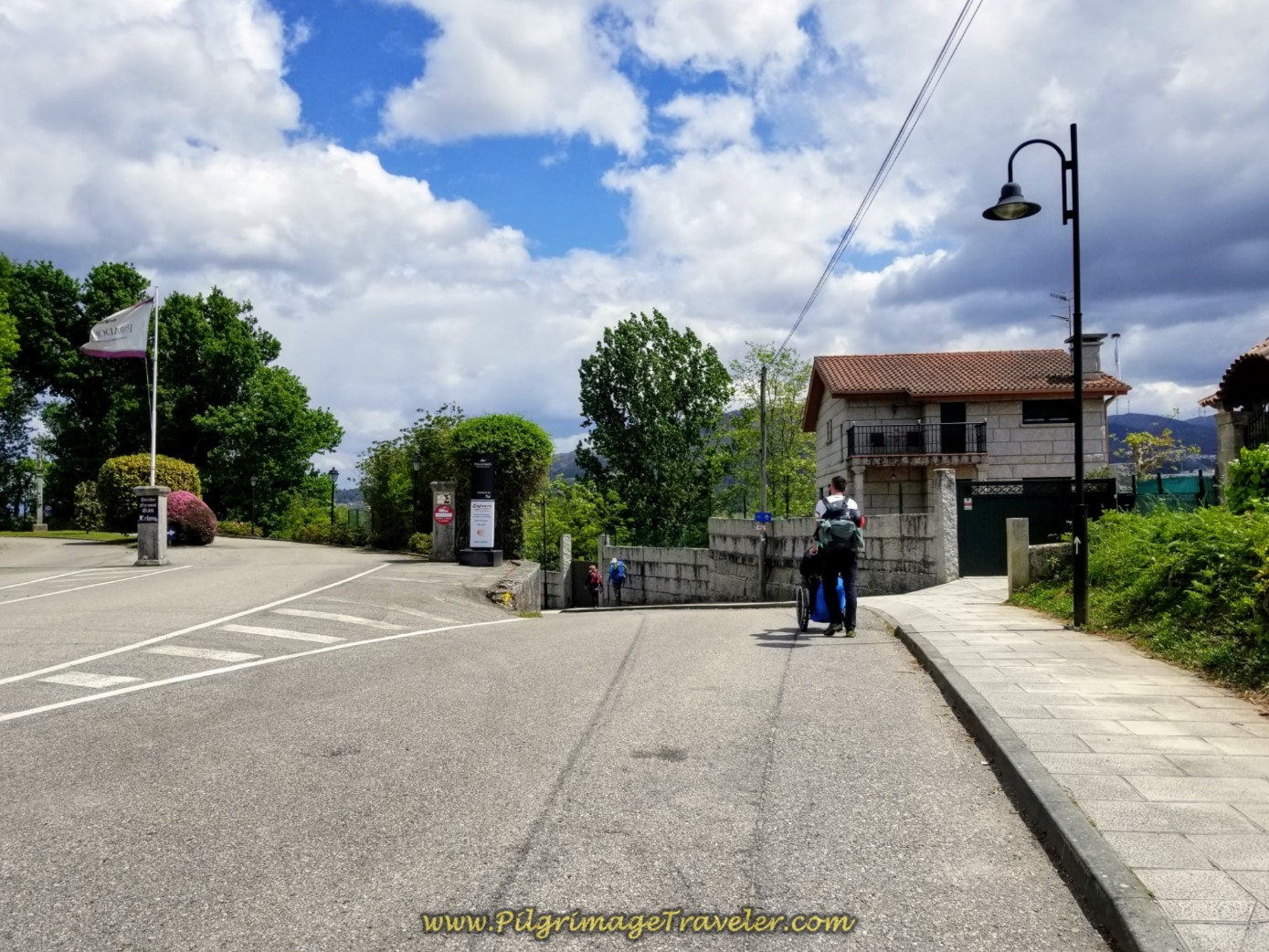 Borut and Magdalena on the Camiño Tenencia
Borut and Magdalena on the Camiño TenenciaThe Camiño Tenencia stays right at the Parador and descends back down to the Rio Minho in about 300 meters. Below is a wonderful view back to Valença and its fortifications, from the river banks in Tui. There are five churches in Valença and you can see at least four of the steeples in this photo.
From the Minho River waterfront, take a hard left and onto the Rúa Barca. Follow the Rúa Barca back up the hill, as it bends around to the right, with the cathedral looming above you.
Follow the Rúa Barca for about another 1/2 kilometer, as it enters the medieval city. Come to a T-intersection. Turn left onto the Praza Manuel Caramés, continuing the steady climb. The pension, Raianos, is on this corner.
After reaching the N-551 on your left side, take a hard right and onto the Rúa Piñeiro and climb steeply onward, shown below.
Staying on the Rúa Piñeiro for 150 meters, the next turn is to the left onto the Rúa Sanz for the final push to the Catedral de Tui, pictured here.
 Walking Up the Rúa Piñeiro, Left Turn Ahead
Walking Up the Rúa Piñeiro, Left Turn AheadHere is team Magdalena, getting up the Rúa Sanz. They finally got smart and picked up two pieces of twine they found along the way, to use as pulling handles! Here are Matt, Michal, Magdalena and Magnus.
150 meters later and you pop out onto the Praza de San Fernando, take a right turn and walk another 30 meters, and the Catedral de Tui is before you to your right, shown below. It is a wonderful sight! Unfortunately, it was closed for siesta when we arrived.
The fact that the cathedral was closed did not squelch our cheer. Here is our salute to Magdalena, and her accomplishment with the team thus far. I am not sure which of the gentlemen thought of this idea, but it was fun!
In later years we have been in the cathedral, so if you get the chance, it is very much worth the visit! Pictured next is the intricately carved wooden door depicting the life of Santa Maria and after it the high altar. Click the cathedral link for more information.
 Entryway Door, Catedral de Tui
Entryway Door, Catedral de Tui High Altar, Catedral de Tui
High Altar, Catedral de TuiAfter hanging out on the square, from the cathedral steps we walked around to the north side of the cathedral, and headed northward, winding through the streets of Tui, following the yellow arrows toward our albergue.
The municipal albergue, the Albergue De Peregrinos De Tui, is just a few more steps behind the cathedral to the East. Please note that the albergue gives priority to long distance pilgrims arriving from Portugal. If you are starting in Tui, you may have to wait to get a bed!
There are many, many private albergues in Tui, as it is a starting point for many pilgrims, at the 100 kilometer mark.
There is the Albergue San Martín, (+34 640 61 64 73), Ideas Peregrinas, Jacob's Hostel Tui, Albergue Convento Del Camino, Hostal Albergue Villa San Clemente, and the Albergue Buen Camino all clustered near the cathedral. Farther north and west of the Camino are yet two more private albergues, the Albergue Pallanes, (+34 679 77 47 53), and the Hostal San Telmo (+34 986 90 61 16) next to the train station.
If you desire a hotel for Tui, and there are plenty of those, you can do it through Booking.com, by clicking here.
Eventually we turned east and down the hill, back toward the Minho River to our albergue for the night, the now-closed Santo Domingo. Unfortunatley, the albergue never reopened after the pandemic. This place was just before the Albergue Convento del Camino, right along the Camino. Here we all are having our happy hour before dinner.
 Happy Hour at the Albergue
Happy Hour at the AlbergueWe had a lovely dinner later in a restaurant in the center of town, having the economical pilgrim's menu, to top off an already wonderful day!
Reflections on Day Nineteen, Central Route of the Camino Portugués
Today, we worked like a team, walking together, at times, even looking like a pack! I said to Magnus, "You know, you could be walking much faster if you weren't with all of us. Does this bother you?" He answered, "I would much rather be together with all the fun!" His words reflected the theme of our day nineteen on the central route of the Portuguese Way.
We were moving together, helping one another, physically, emotionally and spiritually. We were Love. We were Life!
Salutation
May your own day nineteen on the central route of the Camino Portugués be full of Love and Life itself as you are building the community that surrounds you! Love is all around you. All you have to do is look. Ultreia!
Camino Portugués Overview
Camino Portugués Stages
Central Route: Lisbon to Porto Stages
Central Route: Porto to Santiago Stages
Senda Litoral or the Coastal Routes: Porto to Santiago Stages
Skip to Central Route Above, for Final Days 22-25 to Santiago
Variante Espiritual Stages
Please Consider Showing Your Support
Many readers contact me, Elle, to thank me for all the time and care that I have spent creating this informative website. If you have been truly blessed by my efforts, have not purchased an eBook, yet wish to contribute, I am exeedingly grateful. Thank you!
Search This Website:
🙋♀️ Why Trust Us at the Pilgrimage Traveler?

We’re not a travel agency ~ we’re fellow pilgrims! (See About Us)
We've trekked Pilgrimage Routes Across Europe since 2014!
💬 We’ve:
- Gotten lost so you don’t have to. 😉
- Followed waymarks in the glowing sunlight, the pouring rain and by moonlight. ☀️🌧️🌙
- Slept in albergues, hostels & casa rurals. Ate and drank in cafés along the way. 🛌 😴
- Created comprehensive and downloadable GPS maps and eBook Guides, full of must-have information based on real pilgrimage travels. 🧭 🗺️
- Shared our complete journeys, step by step to help YOU plan your ultimate pilgrimage and walk with your own Heart and Soul. 💙✨
Every detail is from our own experiences. Just fellow pilgrims sharing the Way. We have added a touch of spirituality, heartfelt insights and practical guidance from the road ~ offering a genuine connection to the spirit of pilgrimage. Tap into the wisdom of seasoned pilgrims!
Ultreia and Safe Pilgrimage Travels, Caminante! 💫 💚 🤍
Follow Me on Pinterest:
Find the Pilgrimage Traveler on Facebook:
Like / Share this page on Facebook:
***All Banners, Amazon, Roamless and Booking.com links on this website are affiliate links. As an Amazon associate and a Booking.com associate, the Pilgrimage Traveler website will earn from qualifying purchases when you click on these links, at no cost to you. We sincerely thank you as this is a pilgrim-supported website***
PS: Our eBook Guide books are of our own creation and we appreciate your purchase of those too!!
Shroud Yourself in Mystery, along the Via de Francesco!
Walk in the Footsteps of St. Francis, and Connect Deeply with the Saint and to Nature in the Marvelous Italian Countryside!
Need suggestions on what to pack for your next pilgrimage? Click Here or on the photo below!
Find the Best Hotel Deals Using This Tool!
Carbon Trekking Poles ~ My Favorites!
Carbon fiber construction (not aluminum) in a trekking pole makes them ultra lightweight. We like the Z-Pole style from Black Diamond so we can hide our poles in our pack from potential thieves before getting to our albergue! There are many to choose from! (See more of our gear recommendations! )
Gregory BackPack ~ My Favorite Brand
Do not forget your quick-dry microfiber towel!

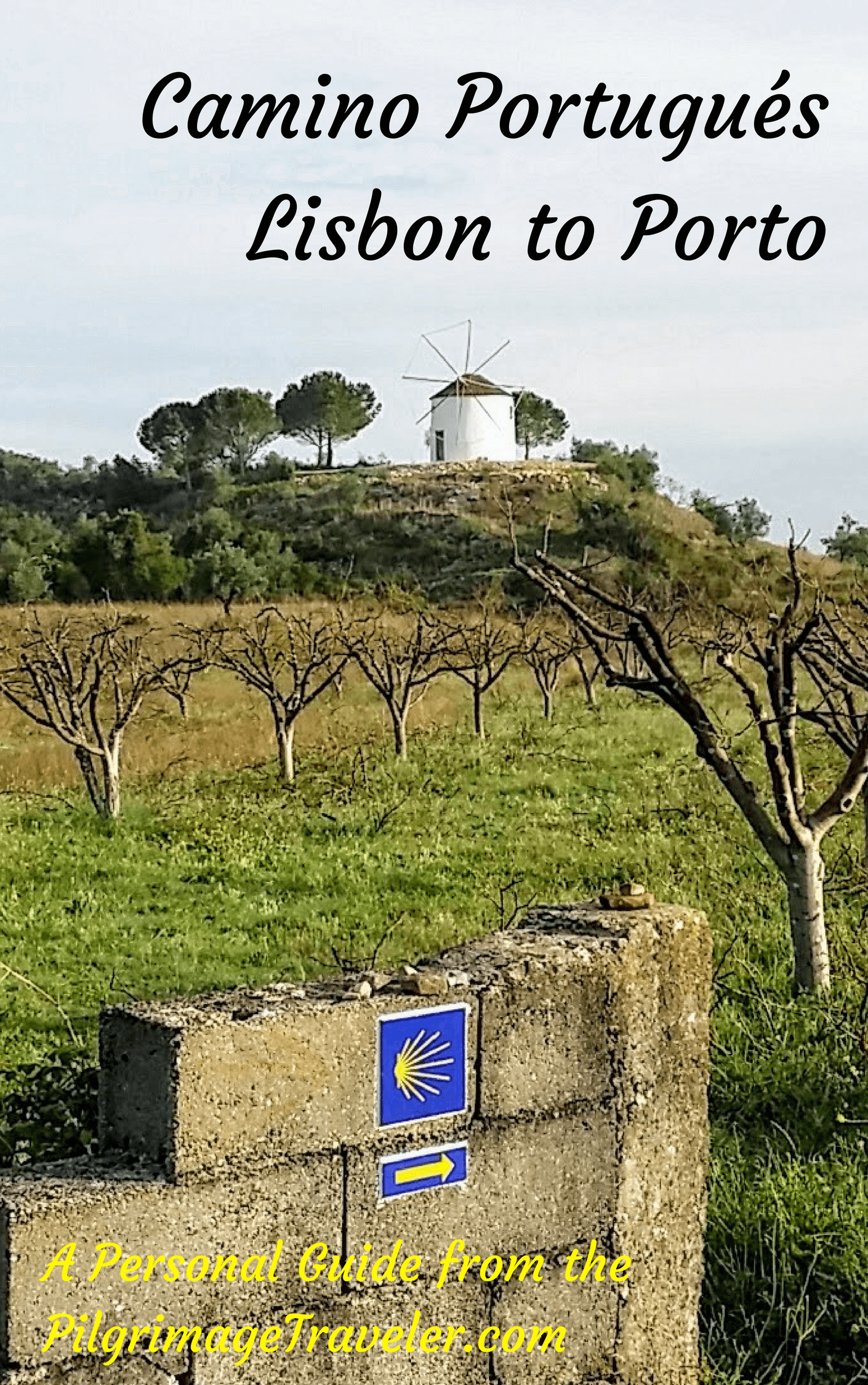






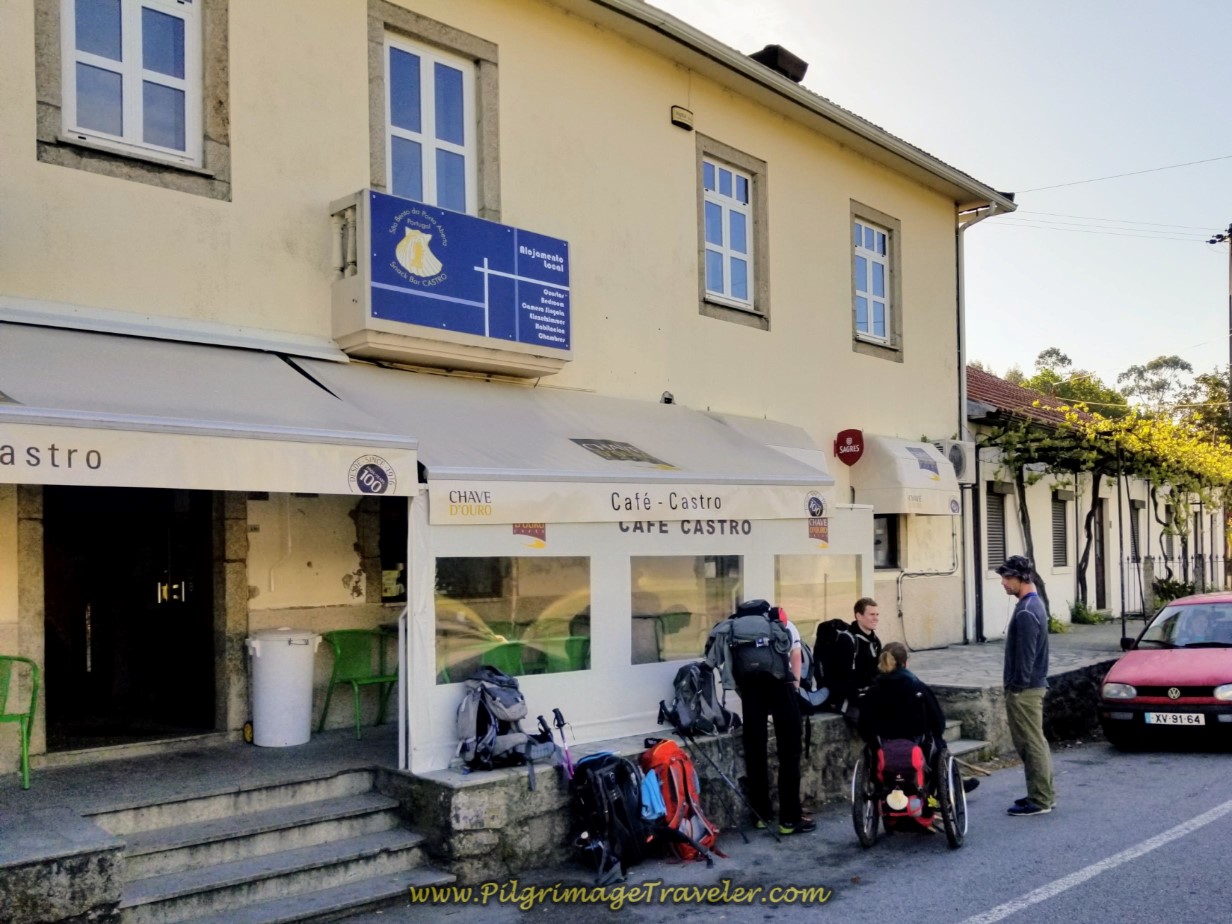
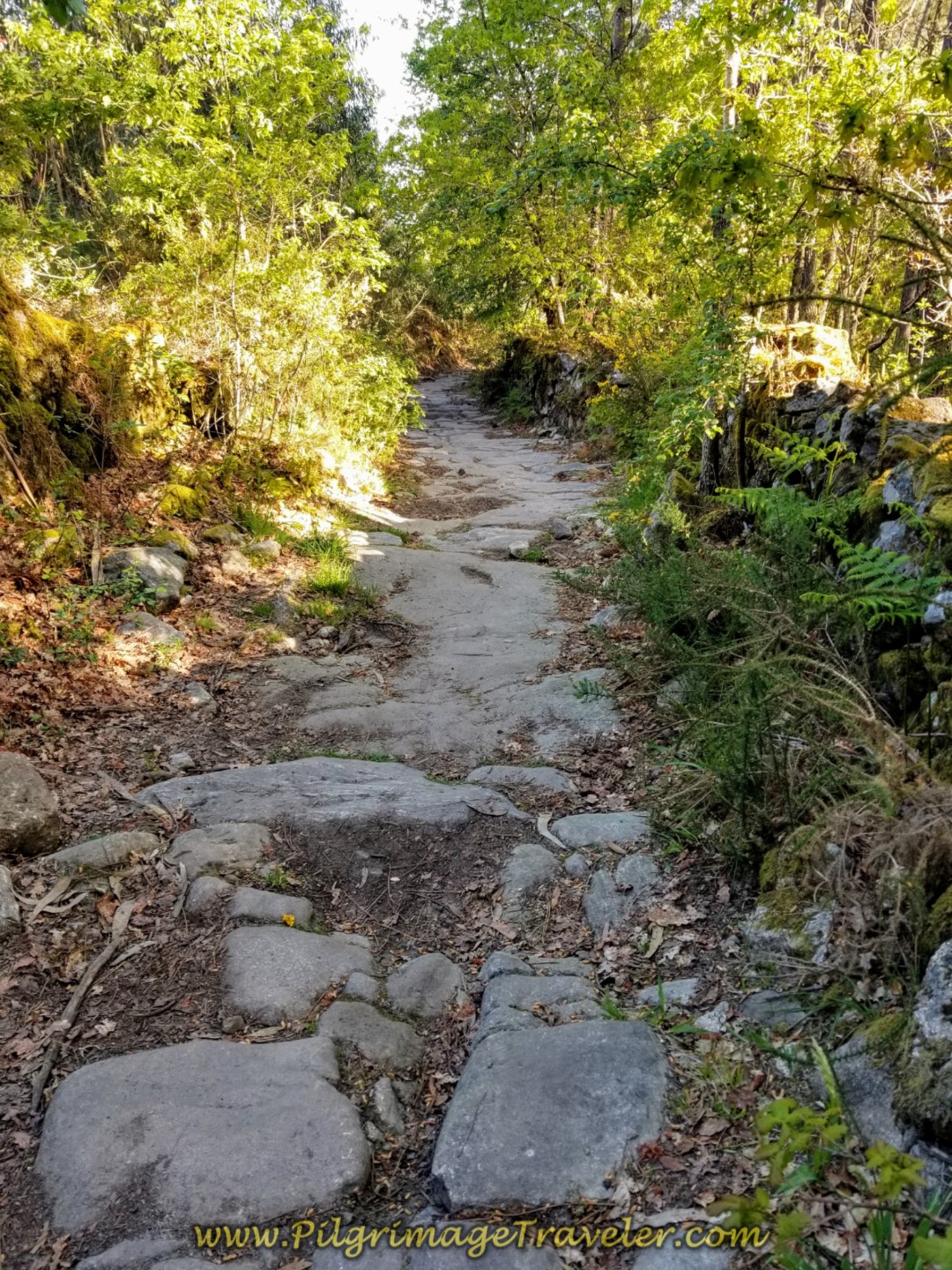
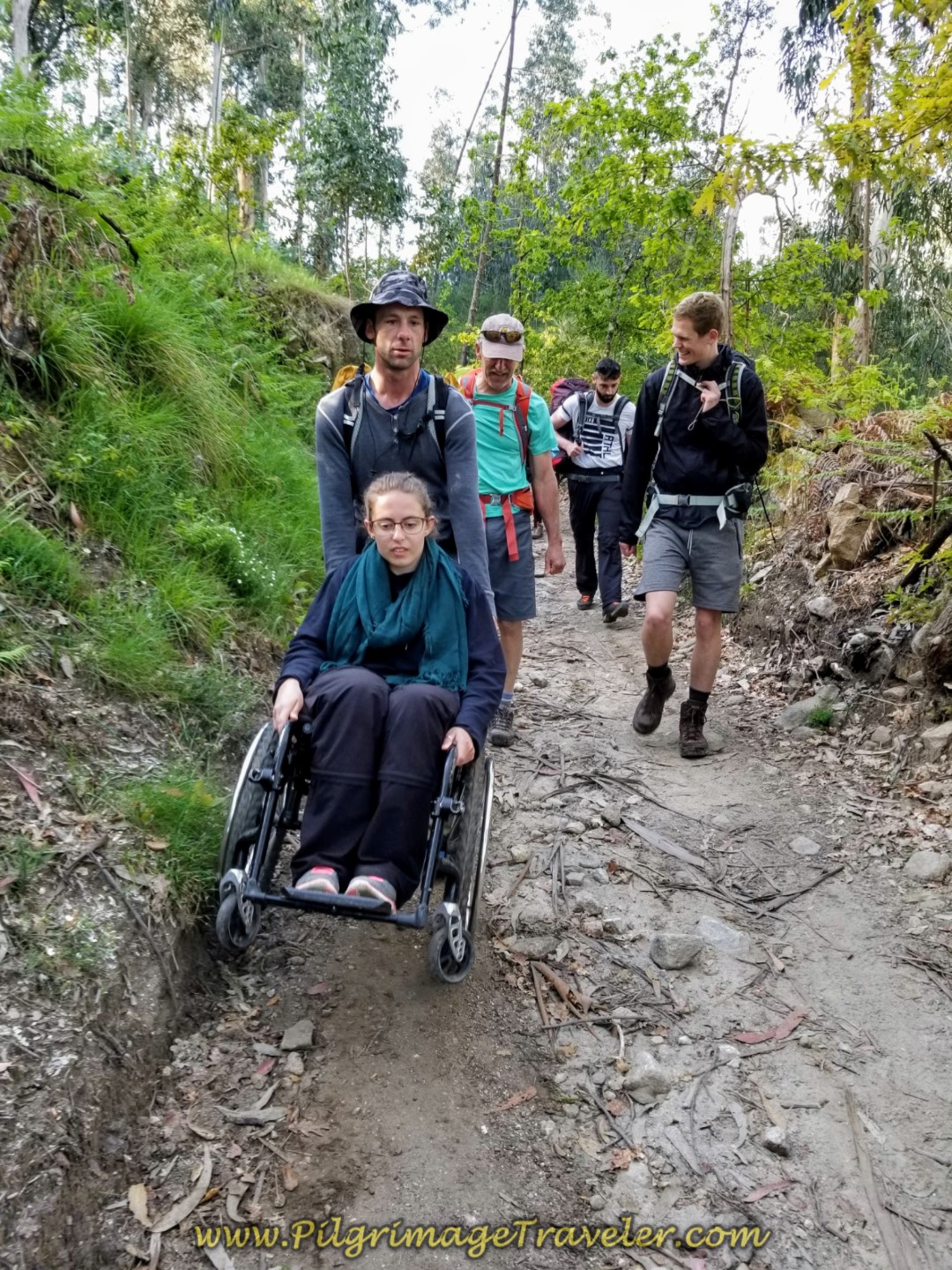




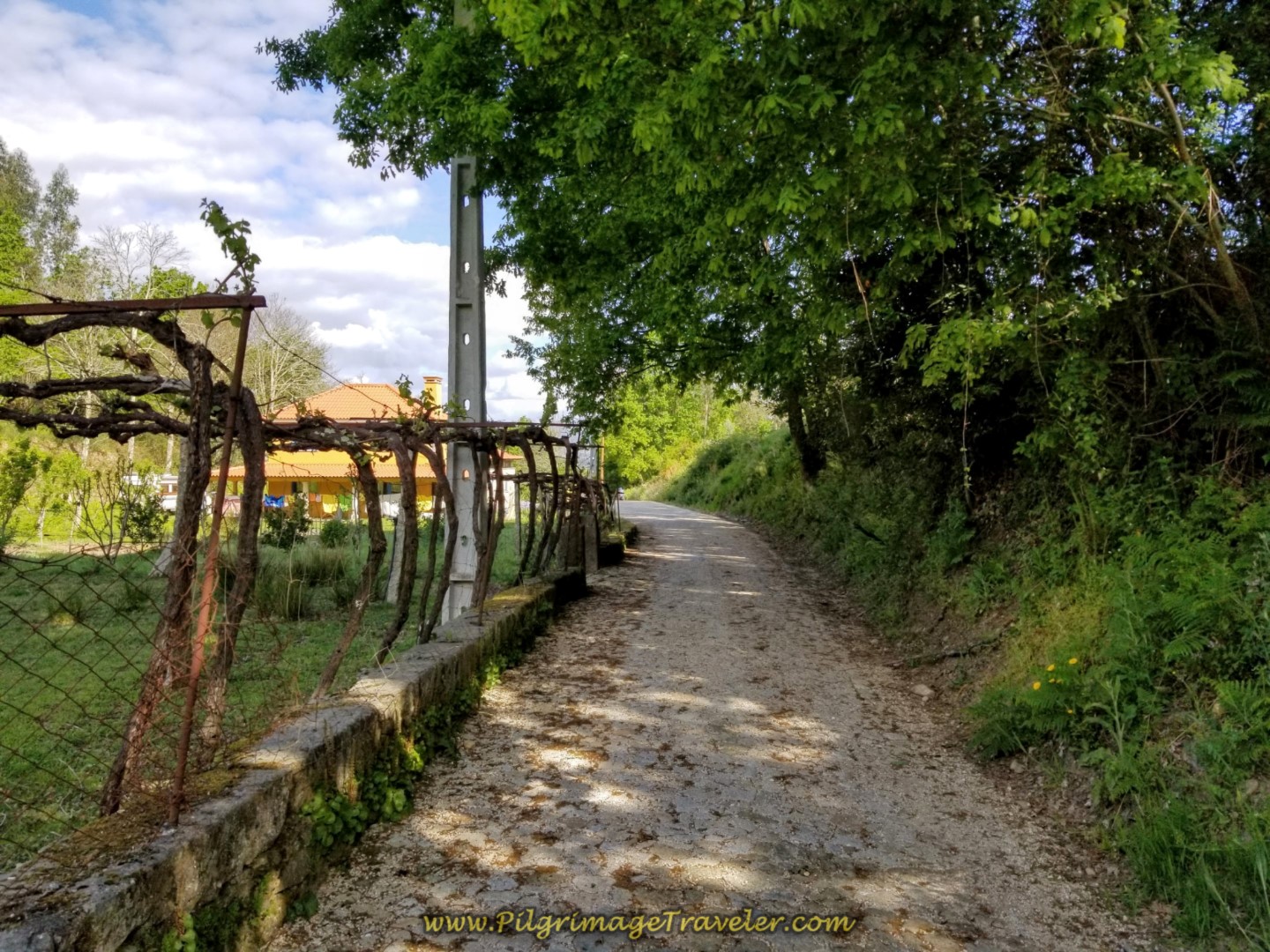


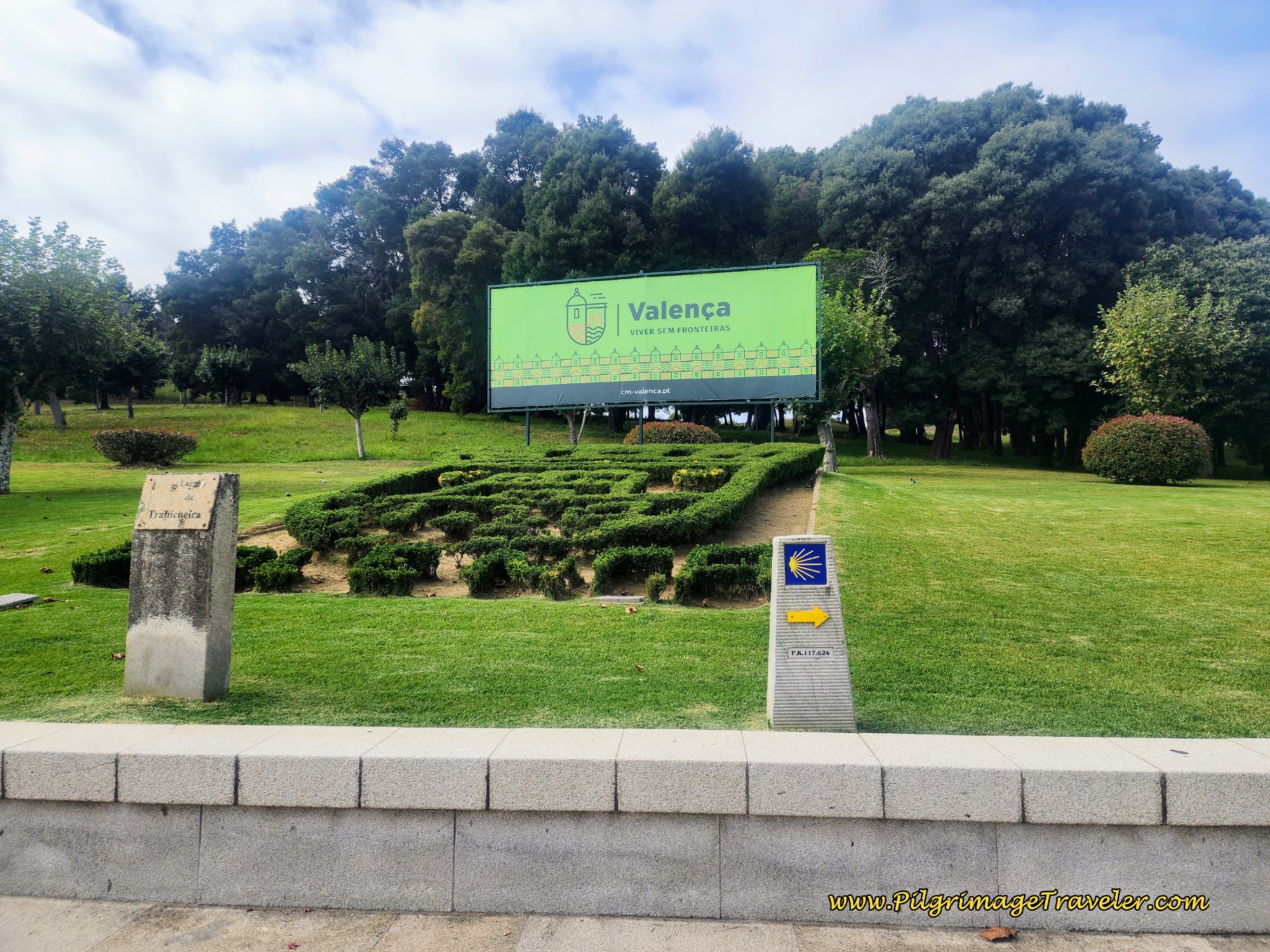




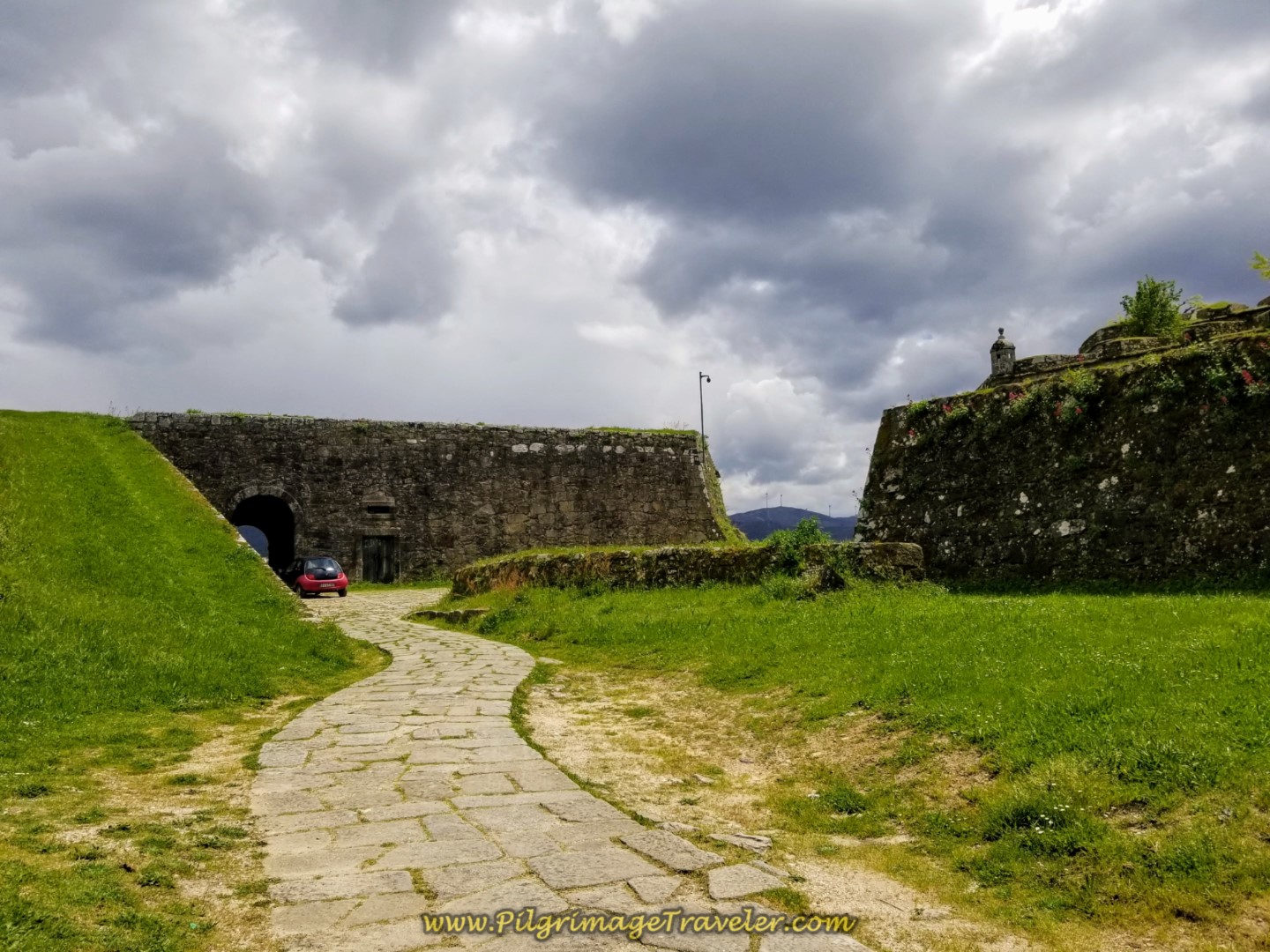
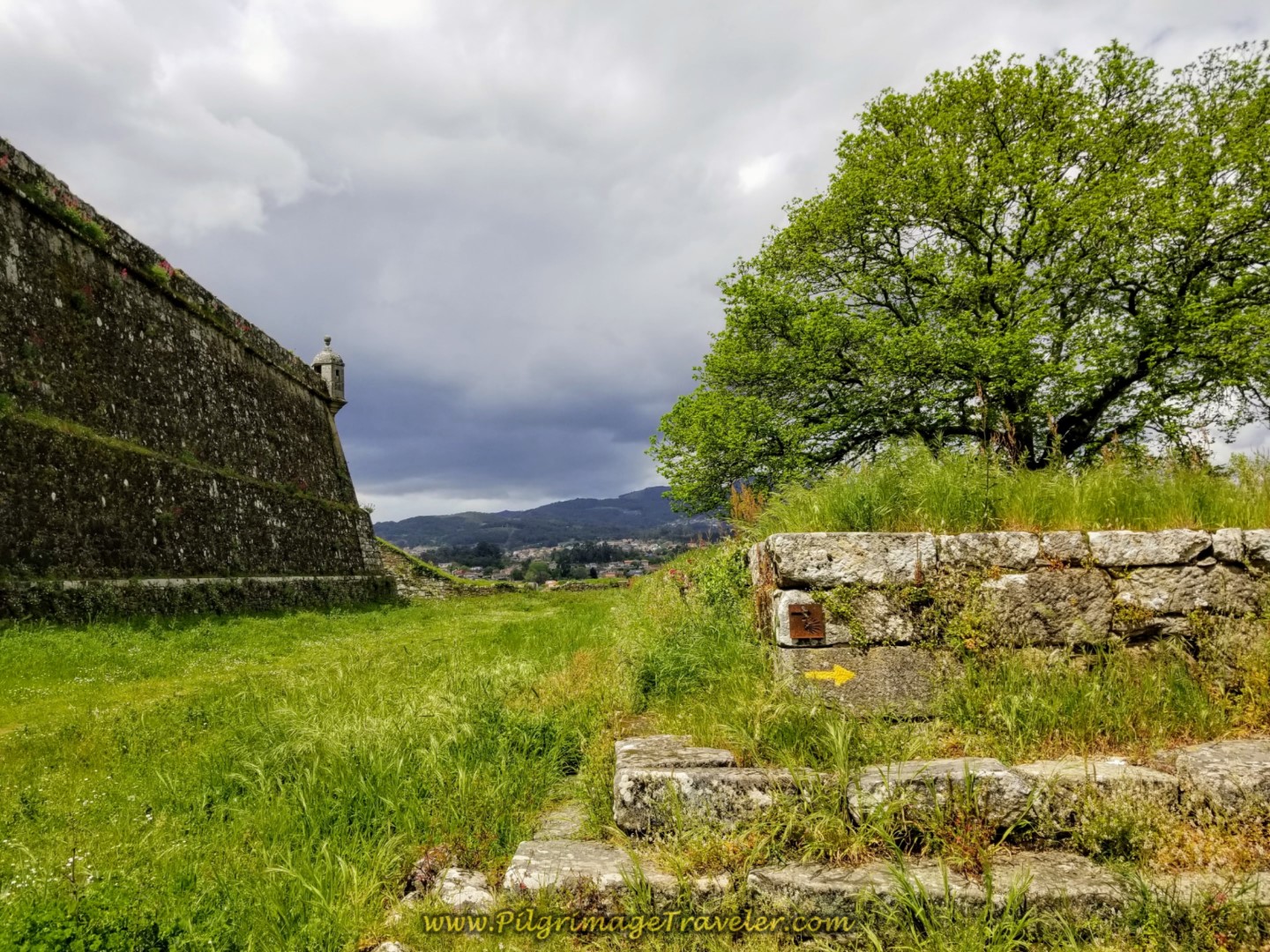

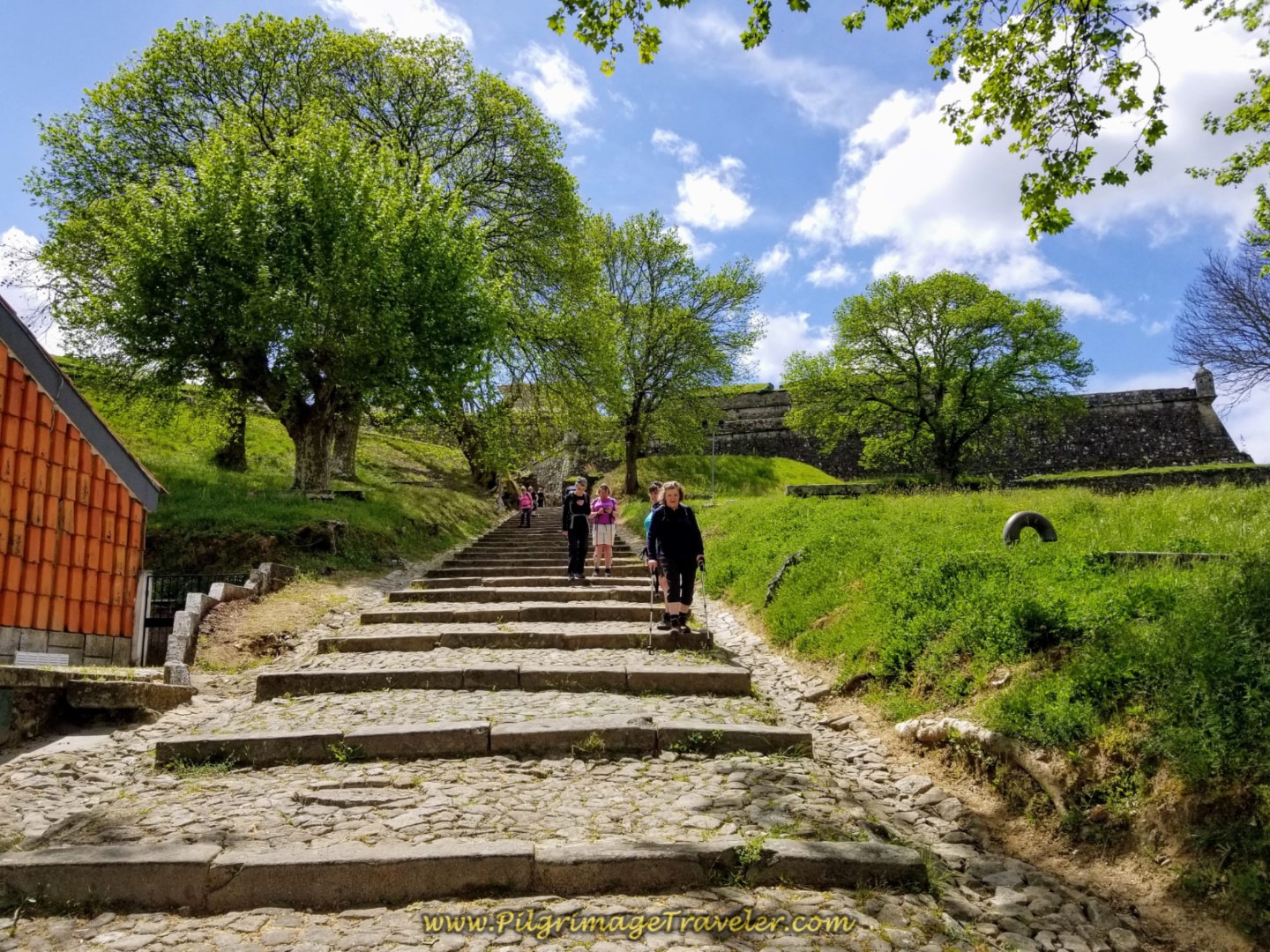
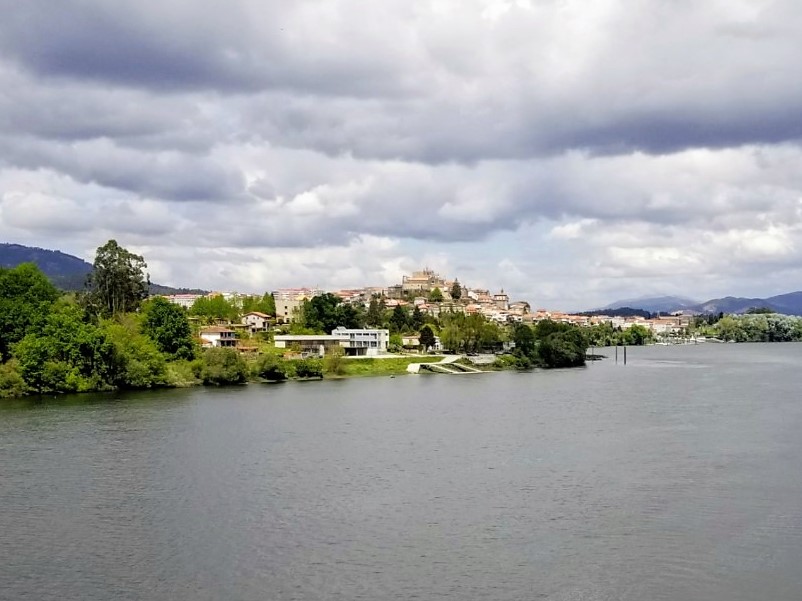










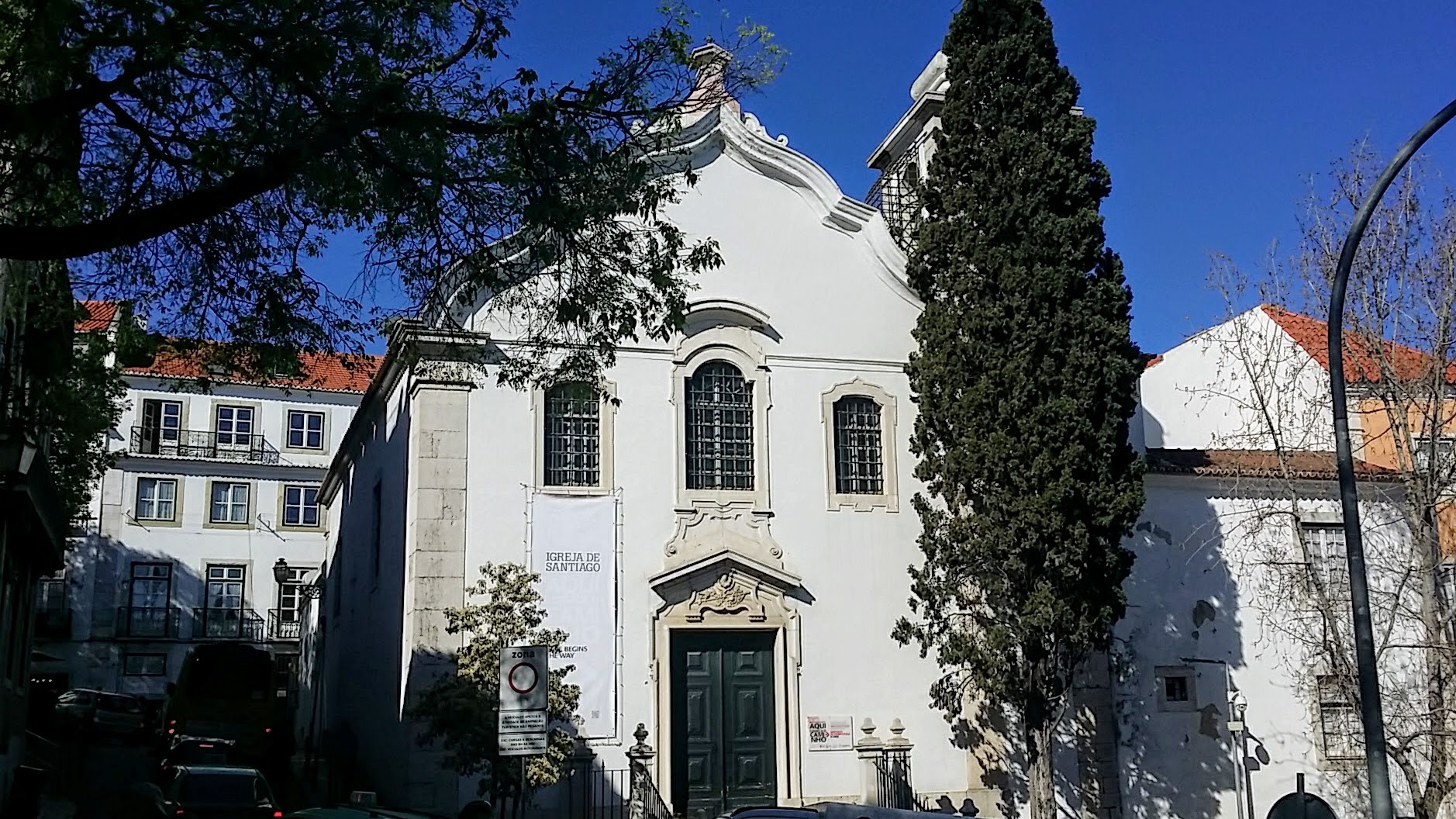


















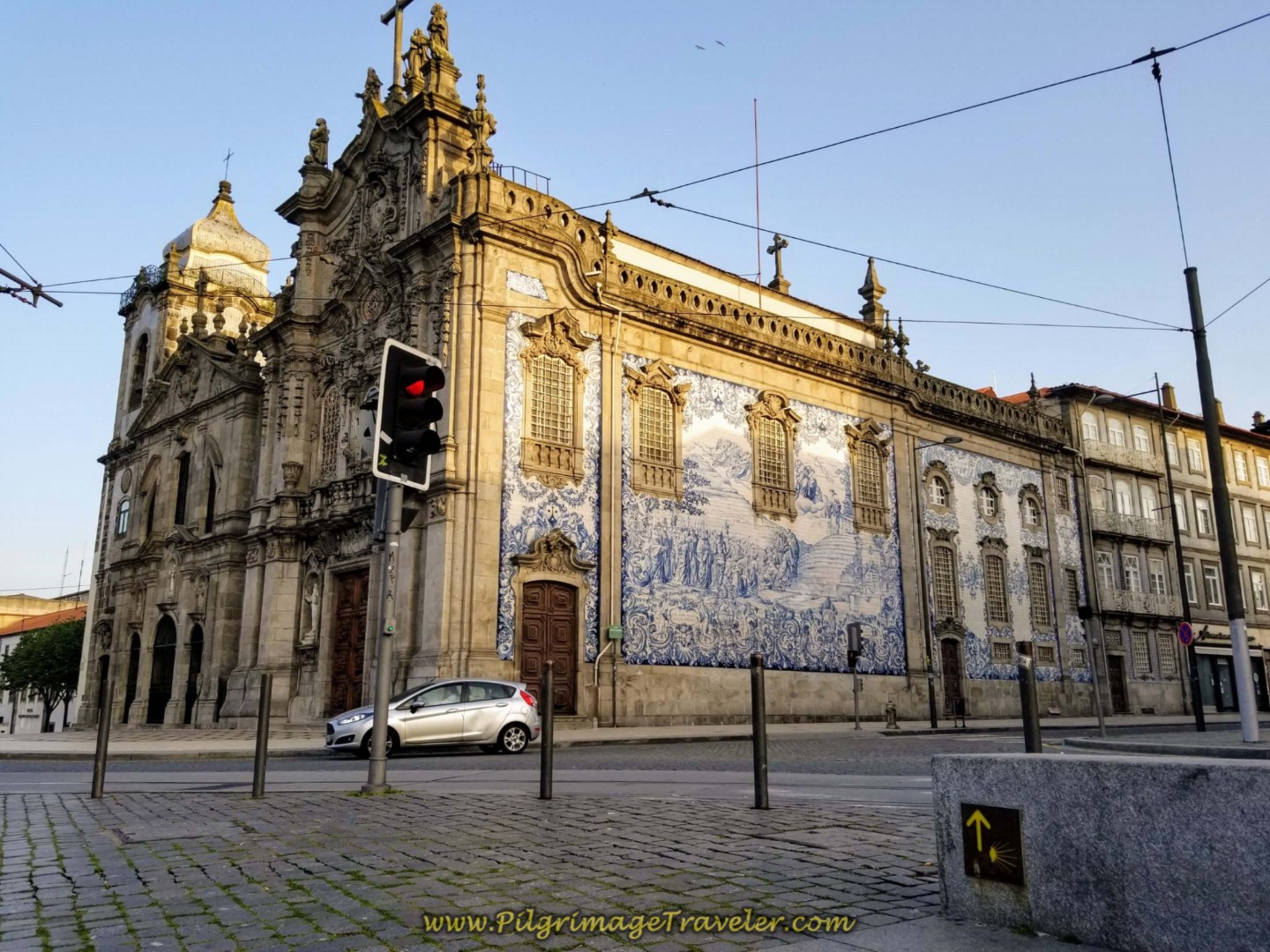









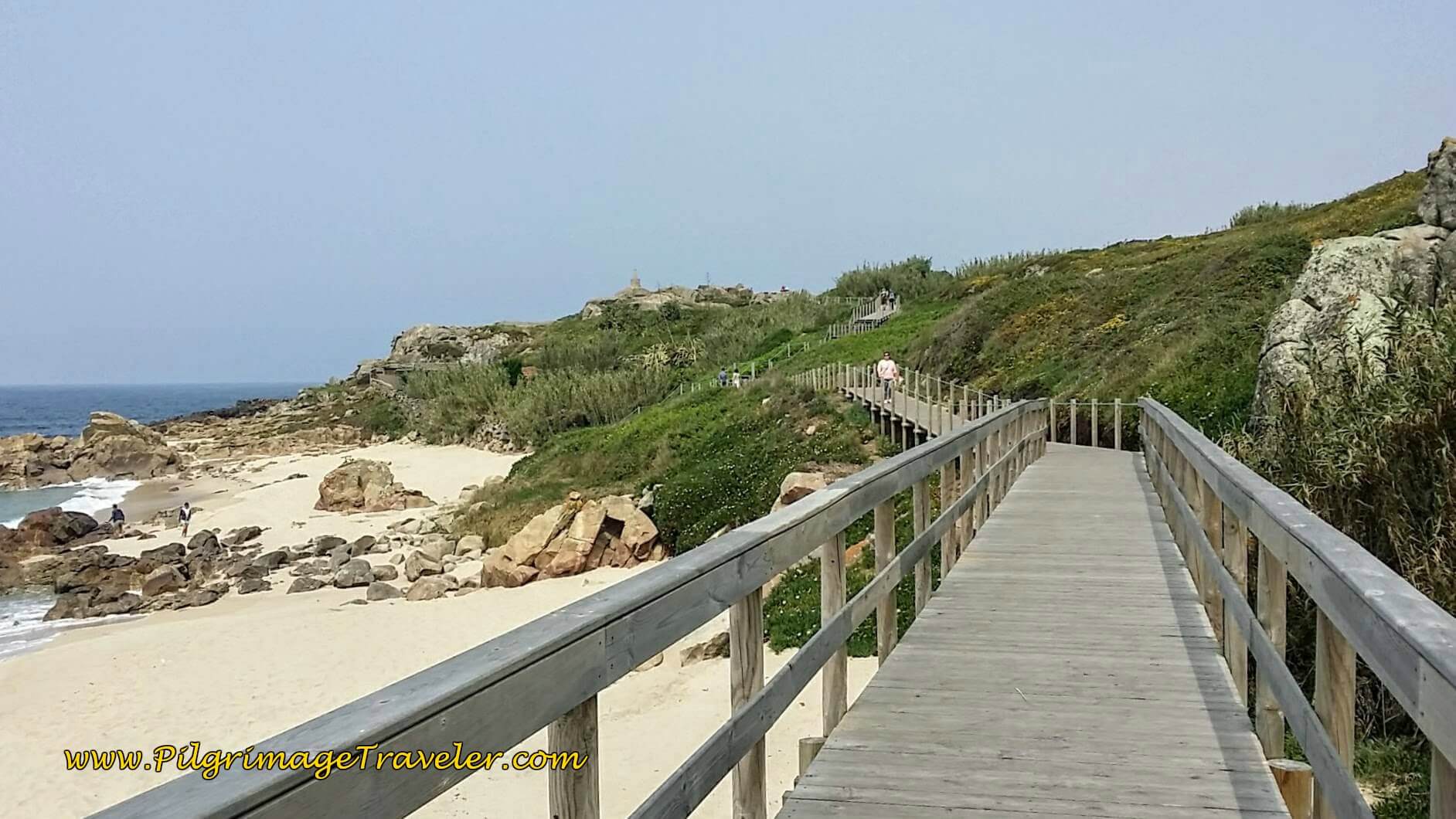













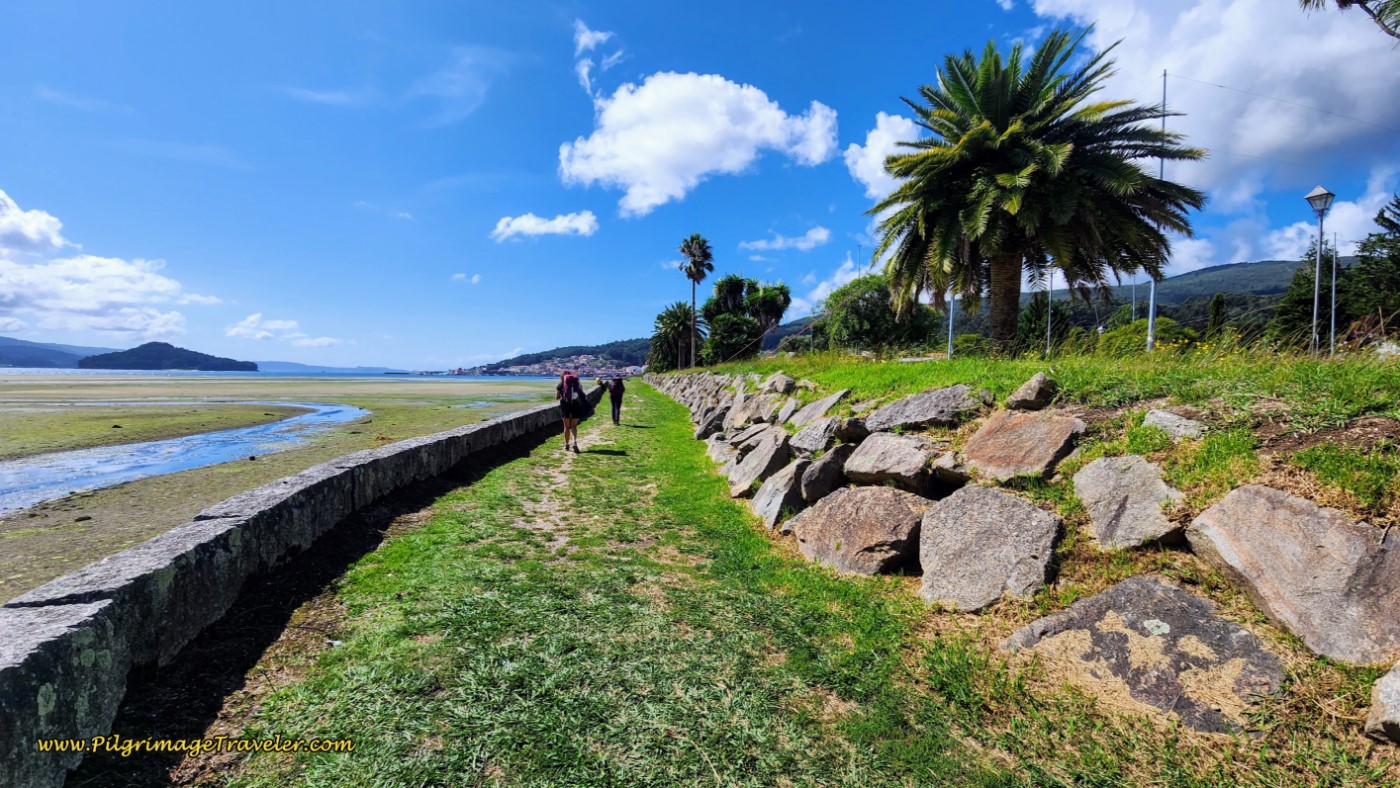







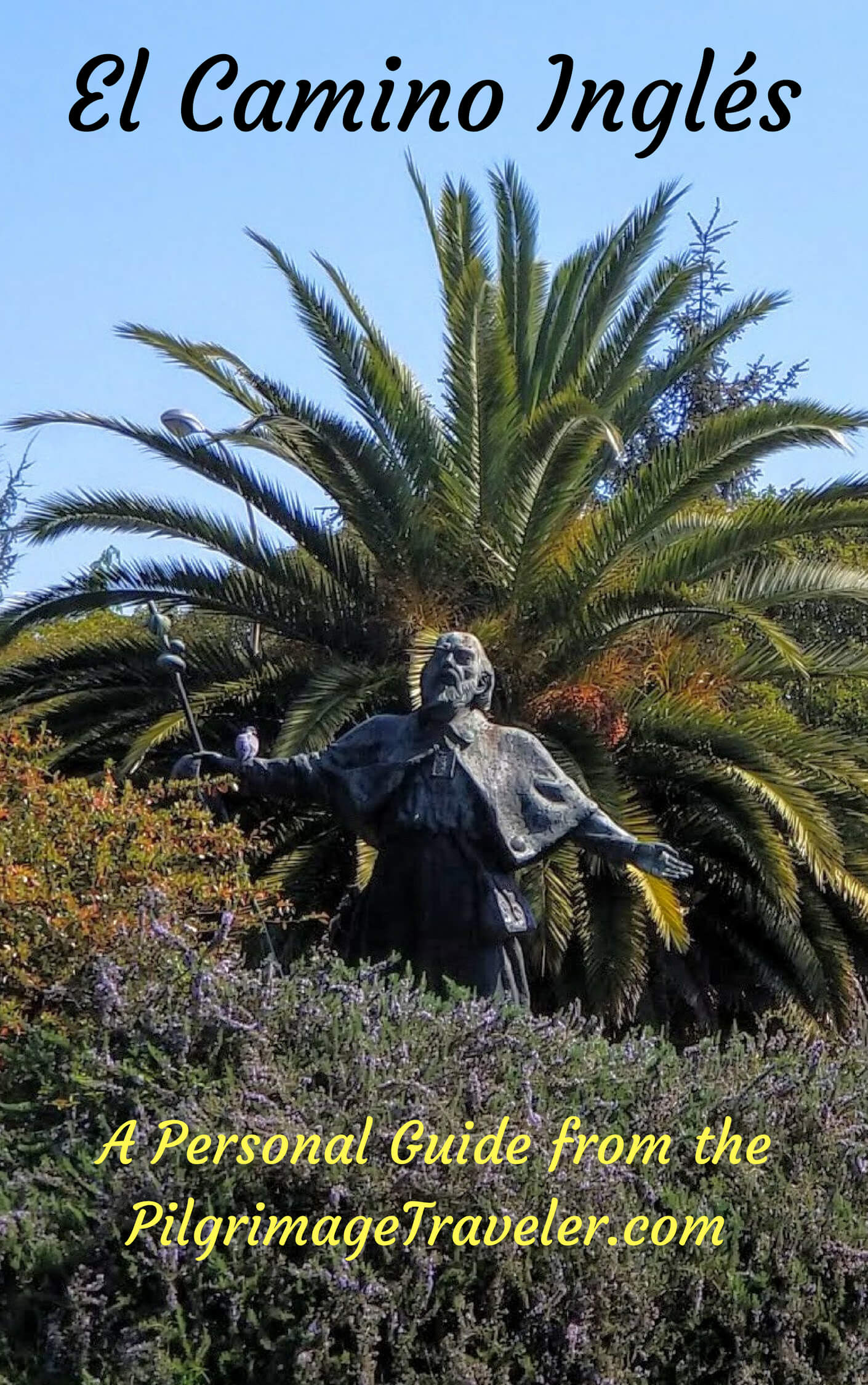







Your Opinion Matters! Comments
Have you had a similar experience, have some advice to give, or have something else you'd like to share? We would love to hear from you! Please leave us a comment in the box below.